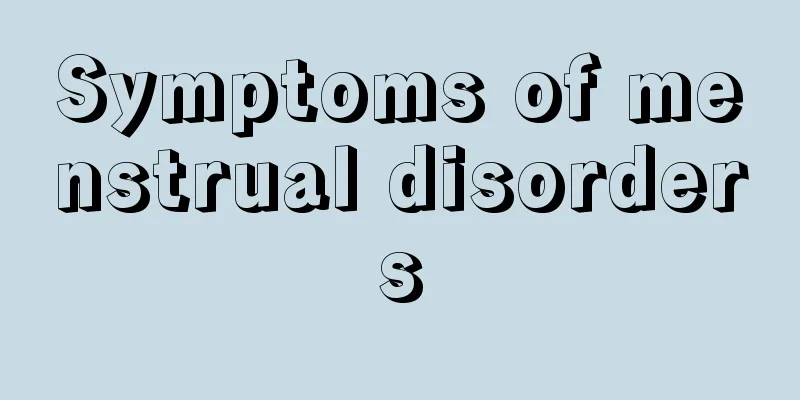Symptoms of menstrual disorders

|
When it comes to menstrual disorders, I believe many women have experienced it. People who have menstrual disorders are generally in pain, and menstrual disorders have a great impact on the human body. There are many reasons for menstrual disorders, and there are also many symptoms of menstrual disorders. For the phenomenon of menstrual disorders, we should all take corresponding measures in our lives. So, how can menstrual disorders be cured? Menstrual disorders, also known as irregular menstruation, are common gynecological diseases, manifested as abnormal menstrual cycles or bleeding volume, and may be accompanied by abdominal pain and systemic symptoms before and during menstruation. The cause may be organic disease or functional disorder. Clinical manifestations There are several situations in which the disorder of menstrual cycle or bleeding volume is manifested: 1. Irregular uterine bleeding This is a clinical symptom, including: heavy menstrual bleeding or prolonged menstrual bleeding. It is common in diseases such as uterine fibroids, endometrial polyps, endometriosis or dysfunctional uterine bleeding. 2. Dysfunctional uterine bleeding It refers to abnormal uterine bleeding caused by endocrine regulation system disorders without obvious organic lesions in the internal and external genitalia. It is the most common type of menstrual disorder and is common in adolescence and menopause. It is divided into two categories: ovulatory and anovulatory. About 85% of cases are anovulatory functional uterine bleeding. 3. Amenorrhea It is a common symptom in gynecological diseases and can be caused by a variety of different reasons. Amenorrhea is usually divided into primary and secondary types. Those who have not had menstruation by the age of 18 are called primary amenorrhea; those who have no menstruation for more than 6 months at any time after menarche and before normal menopause (except pregnancy or lactation) are called secondary amenorrhea. 4. Menopause Menopause means the cessation of menstruation, which refers to the cessation of menstruation for more than 12 months. However, there are often changes in menstrual cycle and menstrual volume during perimenopause. It manifests as a shortened menstrual cycle, mainly a shortened follicular phase, anovulation and increased menstrual flow. Through the detailed description in the above article, I believe most people should have understood the symptoms of menstrual disorders. In fact, as mentioned above, there are many symptoms of menstrual disorders, and the more common ones are irregular uterine bleeding, dysfunctional uterine bleeding, amenorrhea and menopause, etc. Knowing the specific symptoms of menstrual disorders can help to treat them. |
<<: How to regulate scanty menstruation
>>: What to eat for girls with dysmenorrhea
Recommend
Use vinegar to whiten private parts quickly?
Generally, girls' private parts are pink when...
But I couldn’t be happy after entering university!
This is the 3430th article of Da Yi Xiao Hu Amina...
How to grow mung bean sprouts without them rotting? What is the reason for the bean sprouts not growing thick after soaking?
Bean sprouts are a very common food in our daily ...
What is Bilateral Breast Duct Dilatation?
Although bilateral mammary duct dilatation is com...
How to prevent vaginal hyperplasia and vaginal itching
The vagina is a unique organ of women and a symbo...
What is uterine teratoma?
We know that in today's society, everyone is ...
What are the side effects of using anesthesia for caesarean section
Pregnant women feel a lot of pain during childbir...
How to treat coldness in women's bodies?
We all know that women can enjoy life better if t...
How to develop full and sexy breasts?
Modern women pursue not only a slim figure, but a...
Is it normal to feel sleepy during late pregnancy?
Pregnant women begin to slack off when they reach...
SquareTrade: iPad mini tops list of most fragile devices
SquareTrade, a third-party analysis agency in Eur...
A brief discussion on the prevention of breast cancer
Breast cancer is a common cancer among women and ...
I have small itchy bumps in my vagina.
Vulvar itching is mainly caused by gynecological ...
What is the best way to maintain cervical erosion?
With the rapid development of today's society...
What should I do if I have uterine erosion?
Uterine erosion is a common disease in women, esp...









